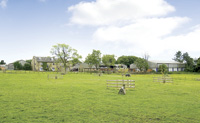Farmland shows evidence of two-tier market

Farmland values have strengthened in the past three months, although a two-tier market is emerging,
according to research by two leading agents.
Smiths Gore’s database of publically-marketed land showed the amount of bare land for sale in the second quarter of the year was 7% down on the same three months in 2008, helping to firm values. “Our farm agency valuers say prices have increased in the second quarter of 2009 to an average of £5,300/acre,” said head of farm agency Giles Wordsworth.
“This rise in values, at a time when most other property assets are dropping in value, is due to continued strong demand from farmers, rather than non-farmer buyers,” he said.
However, there was also evidence that less well-equipped farms, or those with less productive land, saw values slip. Smiths Gore’s figures showed that, overall, farm values fell from £7,800/acre in the first quarter of 2009 to £7,400/acre by June.
Head of research Jason Beedell said this weakness reflected poorer farms where the market was not prepared to pay the same values. “Some of these have struggled to sell and have had unrealistic guide prices reduced. We are seeing more price reductions in our database. It is these farms that are causing the average price to fall compared with the firm values seen by our people.”
Savills’ latest market update recorded a slightly more modest growth in values. Head of research Ian Bailey said a degree of growth had been seen in all types of land during the second quarter but bare arable land saw the strongest growth. “The average value of grade three arable land increased 2.1% to £4690/acre, while average grade three pasture values across England strengthened by just 1.5% to average almost £4,100/acre.
“The demand for arable land has influenced the average regional figures for all land types. The greatest regional increases in values were recorded in the east of England (7%), East Midlands (2.1%) and the south-west (3.6%), where the strength of the arable land market in Wiltshire and Dorset resulted in a boost in values for this region,” said Mr Bailey.
The availability of publically marketed farmland remained significantly reduced. “In Britain, 85,000 acres were marketed in the first half of 2009 compared with almost 90,000 acres in the 2008 period, tightening supply by another 5%,” Mr Bailey said.
“This is the lowest level for the first half of a year since 2005, when landowners were uncertain of how the single payment scheme would impact on the market.”
The Farmers Weekly Land Tracker, which monitors the number of acres advertised in the magazine, confirmed this, recording 82, 026 acres, a fall of 7% on the same time last year.
